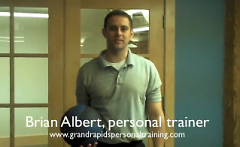Balance. One might think of it as something that older people need to be concerned with or as something those who practice yoga are working to attain. But, balance for runners is important, too.
"Balance is basically making sure your body is in proper alignment and stays in proper alignment. Lots of people think it is static or still thing but balance is really dynamic," said Brian Albert, owner/trainer, Grand Rapids Personal Training www.grandrapidspersonaltraining.com When many different forces are being applied to the body--forward motion, footstrike, arm motion and varied terrain, a runner needs to stay stable. "Balance has a lot to do with the core keeping your spine and posture in correct alignment and when you have good balance and posture it is ensuring your body is moving the proper way," said Albert.
Having good balance makes a runner's movements more efficient and energy isn't wasted. "Good balance also ensures that you are applying force with proper joint angles," he added. That will help runners to NOT add undue stress to knees, ankle and hips; helping keep the runner healthier longer. It also optimizes how force is applied, that is, muscles and joints work better together when balance is present. "Think about when you're doing an exercise or anything when you're off balance. It is much harder to generate force. By having good alignment, you'll be able to apply the optimum amount of force," he said.
While some people may be more naturally "balanced" Albert believes in the use it or lose it adage for balance and believes improving one's balance comes with practice. "If you don't challenge your muscular system and how your muscles interact with one another you won't have good balance. I've see it in people I train and it is one are where I can see big differences when we work at it," he said.
Balance can be improved by working in an unstable, but controlled environment. "So, if you can make yourself unstable, but still control what you're doing, that's good," he said. It can be as simple as standing on one leg then the other; hopping on one leg; or standing on a cushy surface like a mat, carpet or grass when doing an exercise.
Reactive training, which was discussed in a previous article http://www.therapidian.org/news/reactive-training-runners are complementary exercises. "Balance comes first. You need to have the proper joint angles before you apply the reactive training. If you're off balance or have improper joint angles, you're more likely to get hurt. Make sure your balance is correct first, then apply the reactive," said Albert.
The Rapidian, a program of the 501(c)3 nonprofit Community Media Center, relies on the community’s support to help cover the cost of training reporters and publishing content.
We need your help.
If each of our readers and content creators who values this community platform help support its creation and maintenance, The Rapidian can continue to educate and facilitate a conversation around issues for years to come.
Please support The Rapidian and make a contribution today.

